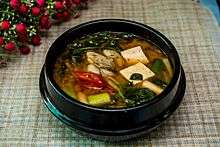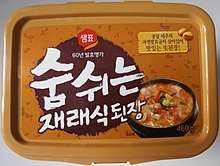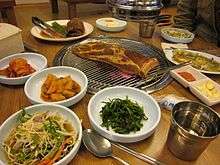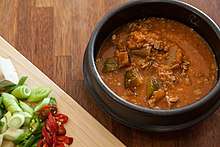Doenjang-jjigae
Doenjang-jjigae (Korean: 된장찌개; Korean: [twen.dʑaŋ.t͈ɕi.ɡɛ]), referred in English as soybean paste stew, is a Korean traditional jjigae (stew-type dish), made from the primary ingredient of doenjang (soybean paste), and additional optional ingredients vegetables, seafood, and meat[2]. It is one of the most iconic and popular traditional dishes in Korean cuisine, and is often eaten regularly regardless of occasion or time of day. Doenjang-jjigae was initially made with home-made doenjang, however due to extensive industrialisation of soybean paste, households and restaurants nowadays use factory-made doenjang instead as their ingredient. From traditional to modern Korean cuisine, doenjang has become one of the most frequently used jang (sauce/paste).
 | |
| Alternative names | Soybean paste stew |
|---|---|
| Type | Jjigae |
| Place of origin | Korea |
| Associated national cuisine | Korean cuisine |
| Main ingredients | Doenjang |
| 160 kcal (670 kJ)[1] | |
| Korean name | |
| Hangul | 된장찌개 |
|---|---|
| Hanja | -醬-- |
| Revised Romanization | doenjang-jjigae |
| McCune–Reischauer | toenjang-tchigae |
| IPA | [twen.dʑaŋ.t͈ɕi.ɡɛ] |
Doenjang-jjigae is often misinterpreted with doenjag-guk (soybean paste soup). The main difference between Korean-style stew and soup is in the method of cooking and serving, where jjigae is thicker, has more ingredients, and is largely served as a dish, whereas guk is served more so as a companion to the rice to be eaten together.
History
The origin of doenjang, which is used as the primary ingredient of doenjang-jjigae, dates back to as early as the Korean Three Kingdoms period[3]. Korea was a largely-agricultural land, with vast farmlands but unstable, insufficient sources of meat, especially during winter. In the search for easily-prepared relief substitutes of sources of protein, Korean farmers began cultivating jang (sauce/paste) from various plants and seeds[4]. Doenjang was first produced during this period through the fermentation of soybeans in the form of meju. Fermented soybean paste is found to be a rich source of isoflavone[5], which helps in preventing cardiovascular diseases and supplies daily nutrients to the body[6].
The first official record of the use of doenjang is written in the Samguk Sagi, the historical records of the Three Kingdoms era registered by government officials and scholars. In the Samguk Sagi, it is recorded that doenjang and other varieties of jang were served at the wedding ceremony of King Sinmun of Silla in 683 CE.
The earliest form of doenjang jjigae is mainly connected to ‘curled mallow soup’, which is mentioned in the Jeungbo sallim gyeongje, a record of Korean agriculture by physician Yu Jung-Rim during the rule of King Youngjo (1724 – 1776). Curled mallow soup is a traditional Korean soup-type dish where mallow leaves and other vegetables are boiled in a doenjang-filled broth, and served as a soup complementary with rice. Since this period, various provinces and regions around the Korean peninsula began to develop their own unique recipes of doenjang-jjigae, and most varieties of these soybean paste stew are still maintained to this day.
Ingredients

There are many variations and subtle differences in the ingredients used in cooking doenjang-jjigae in accordance to its originating province[7]. The ingredients listed in this section provides the primary and typical ingredients which can be commonly found in most servings of doenjang-jjigae. Ingredients included are: Doenjang (fermented soybean paste), dried anchovies, white radish, Korean chilli pepper, minced garlic, water, onions, green onions, potato, zucchini, medium-firm tofu.
Doenjang-jjigae was traditionally cooked with homemade soybean paste, which was commonly prepared in most households, similar to the preparation of kimchi. However, large industrialization processes regarding most jang (sauce/paste) in recent decades have made a nationwide shift to using factory-made doenjang-jjigae products for quick and easy accessibility and preparation.
There are many other alternative ingredients which can be found in doenjang-jjigae for a heartier meal, which is usually through either the addition of meat and seafood. These secondary ingredients significantly changes the taste of the broth and stew[8], therefore is usually referred in a slightly different name according to the ingredient used. Most common seafood ingredients added to doenjang-jjiage includes prawns or small clams, and beef is the most popular and commonly found meat ingredient.
Preparation and Serving

The preparation stage of doenjang-jjiage is largely divided into two stages; the initial boiling of the broth, and following addition of ingredients. The first step of cooking soybean paste stew is making the base broth. The base broth is made by adding dried anchovies and white radish into the pot of water and bring to boil for around 15 minutes. Then, the key ingredient doenjang and chilli pepper is stirred into the broth and mixed carefully. The broth is set to boil for a further 10 ~ 20 minutes before filtering the anchovies out of the broth. Next, ingredients are added into the broth in the general order of potato and zucchini first for enough time for them to ripe, then onions, green onions and tofu, and finishing with the addition of minced garlic for more pungent flavor.
In contrary to doenjang-guk, doenjang-jjigae is served at the center of the dining table, mainly as a sharing dish between 2 or more people. Similarly to other jjigae type dishes, doenjang-jjigae is served alongside steamed rice, and other banchans (side-dishes) consisting of meat or vegetables. Doenjang-jjigae can also be commonly found to be served as an accompanying stew when ordering meat at Korean barbeque, since Korean barbequed meat and doenjang-jjigae is widely accepted to be a hearty and tasty combination.
Varieties

Multiple varieties of doenjang-jjigae can be found in Korean cuisine, each with its individuality in taste, presentation, regionality, and steps of preparation and consumption. These different varieties are usually distinguished by their unique main ingredient, which the dish itself is usually named after, with doenjang-jjigae following it.
- Kkot-Gae (Swimming crab). The carapace and legs of swimming crabs is added in the process of making the broth. The crab adds sweetness and deep taste to the stew.
- Cha-Dol-Bae-gi (Beef brisket). Fried beef brisket in oil is added to the broth and boiled with the rest of the normal ingredients of doenjang-jjigae. Beef Brisket doenjang-jjigae is usually served at Korean barbecue restaurants as a complementary dish to the meat.
- Bajirak (Clam). Clams are de-grited and prepared, then added into a cooked doenjang-jjigae for deeper taste of savory.
- Sundubu (Curdled soft tofu). Medium tofu is usually chosen over soft tofu in cooking stews since soft tofu is very delicate and de-solidifies easily, but soft tofu can be used in cooking doenjang-jjigae for a softer stew for children.
 Gang-Doenjang-jjigae
Gang-Doenjang-jjigae - Dallae (Korean wild chives). Dallae, is added into the broth of doenjang-jjigae just before bringing to boil. The chives releases a pungent and mildly herbal taste into the stew.
- Naengi (Horseradish). The leafy roots of horseradish is blanched in hot water, then added to a cooked doenjang-jjigae at the end for spicy flavor. Horseradish is often consumed for its richness in protein, calcium, and iron nutrients[9].
- Gang-Doenjang. Vegetable ingredients are first stir-fried with doenjang and gochujang, then a reduced amount of water than the amount used in normal doenjang-jjigae recipe is added and brought to boil until the stew has thick consistency.
References
- "doenjang-jjigae" [Soybean Paste Stew]. Korean Food Foundation. Retrieved 12 May 2017.
- Pettid, M. J. (2008). Korean Cuisine: An Illustrated History. London, United Kingdom: Reaktion Books.
- Chon, D. (2002). Korean Cuisine and Food Culture. Special Edition: Exploring the Flow of East Asian Food Culture, 4, 2-6.
- Koo, C. H. (2004). Ganjang and Doenjang: Traditional Fermented Seasoning. Koreana. The Korean Foundation.
- Lee, D. H., Kim, M. J., Park, S. H., Song, E. J., Nam, Y. D., Ahn, J., Jang, Y. J, Ha, T. Y., Jung, C. H. (2018). Bioavailability of Isoflavone Metabolites After Korean Fermented Soybean Paste (Doenjang) Ingestion in Estrogen-Deficient Rats. Journal of Food Science, 83(8), 2212-2221. doi: 10.1111/1750-3841.14214.
- Ahn, J. B., Park, J. A., Jo, H. J., Woo, I. H., Lee, S. H., Jang, K. I. (2012). Quality Characteristics and Antioxidant Activity of Commercial Doenjang and Traditional Doenjang in Korea. Korean Journal of Food and Nutrition, 25(1), 142-148. https://doi.org/10.9799/ksfan.2012.25.1.142
- Saveur. (2016). Doenjang Jjigae (Fermented Soybean Stew). Retrieved from https://www.saveur.com/doenjang-jjigae-korean-soybean-stew-recipe/
- Maangchi. (2016). Fermented soybean paste stew. Retrieved from https://www.maangchi.com/recipe/doenjang-jjigae
- Nast, Conde (2014). "Nutrition facts for prepared horseradish". USDA National Nutrient Database. Retrieved 20 May 2020.